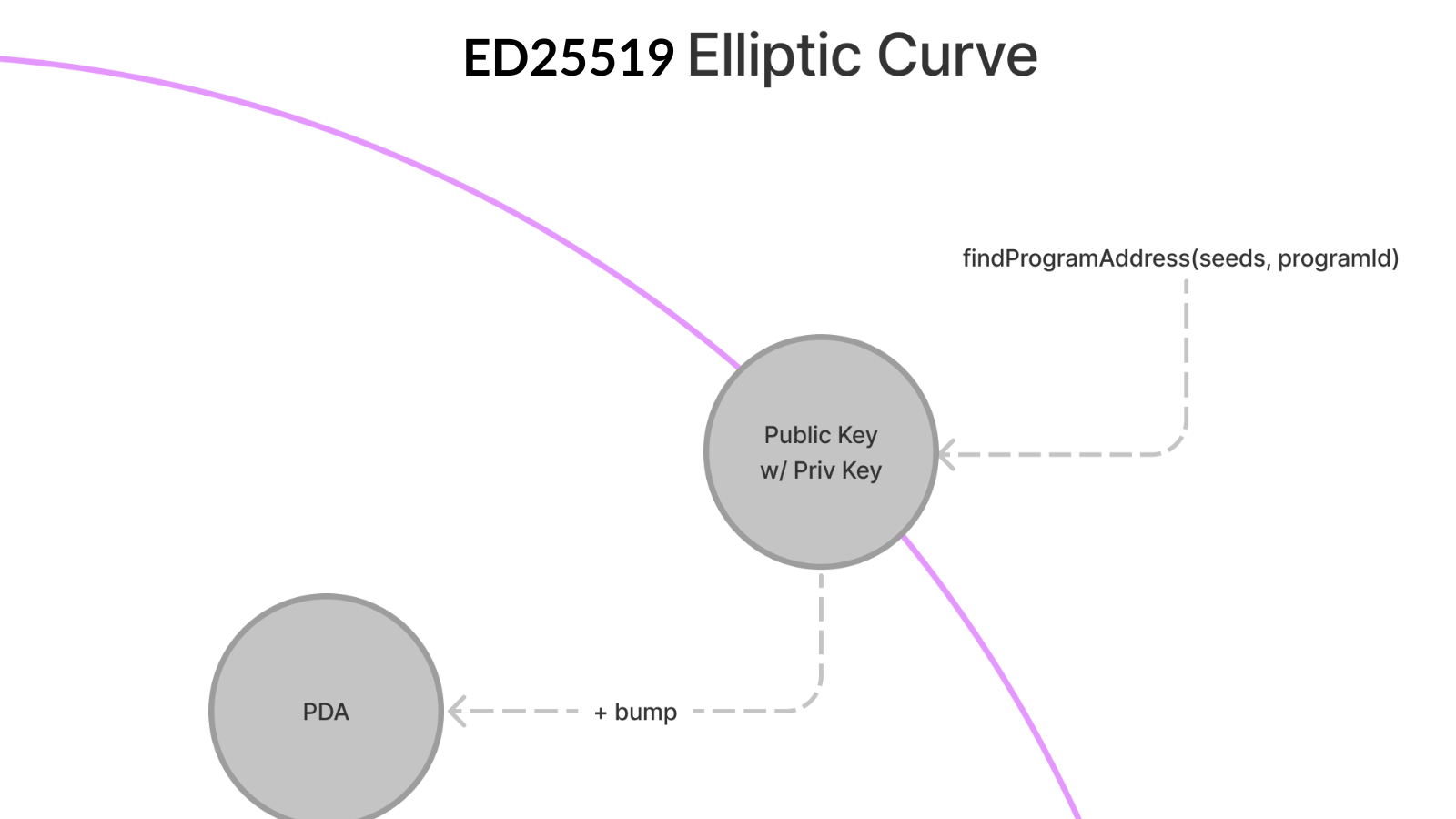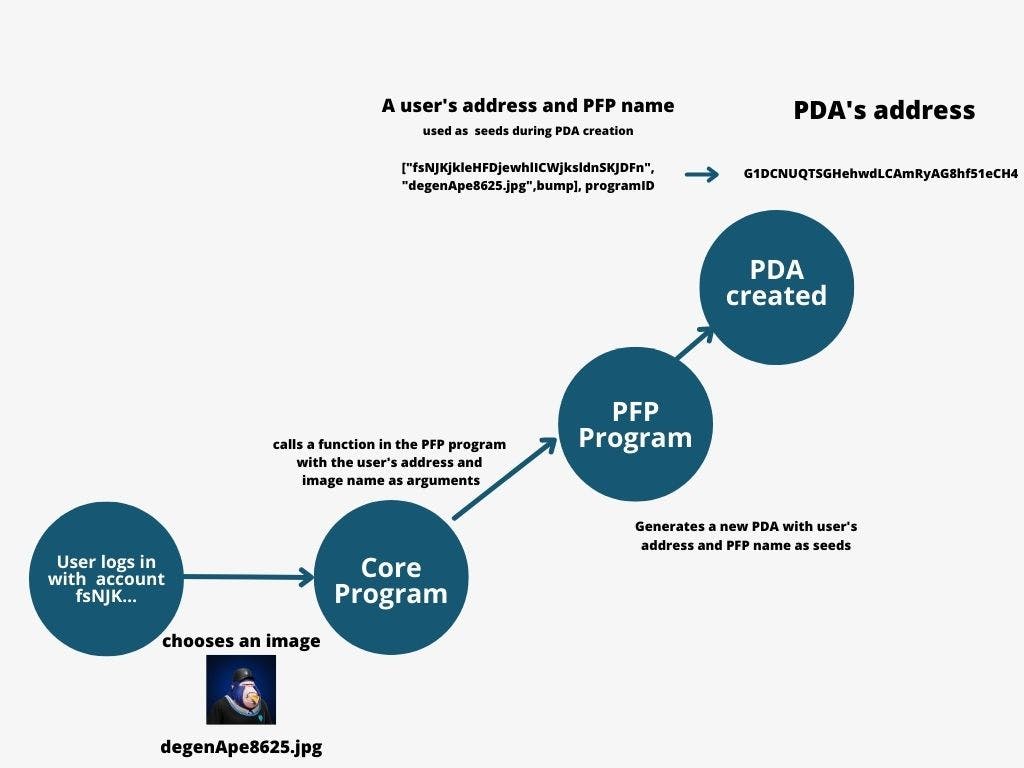
What is a Program Derived Address (PDA)?
Written by Petar Todorov
Program Derived Addresses (PDAs) are accounts on the Solana blockchain that have special properties. Using PDAs properly can make Solana dApp development fast and efficient since they aid in cross-program communication.
This article will explain PDAs, what they are, which problems they solve, how they work, and how they are different from other accounts in Solana's account model.
What is a Program Derived Address (PDA)?
A Program Derived Address is an account on the Solana blockchain that does not have a private key. Since a PDA is not a public key, the address of the account is found using the program ID, a SHA-512 hashing function, seed array, and a special bump seed.
What is a standard account on Solana?
A standard Solana account has both private and public keys (32 bytes each), and together they form a keypair, which is 64 bytes long and sits on an elliptic curve (ED25519). In order for the keypair to be valid it must lie on this curve.
Here is a representation of an ED25519 Elliptic Curve:

How are program addresses derived?
PDAs require three main components:
Parent Program ID - the ID of the parent program that creates the PDA
Seeds - an array of strings*
Bump Seed - makes sure that the PDA does not have a private key
Creating a valid Program Derived Address requires taking the ID of its parent program, the seeds array, and running them through a SHA-512 hashing function.
In about 50% of the cases, however, the result of this hash is a keypair that lies on the ED25519 Elliptic Curve. Because PDAs do not have a private key, Program Derived Addresses must not lie on the elliptic curve. To prevent PDAs from having private keys, a special bump seed is used to “bump” the hash result off the curve.
The bump seed is nothing more than a number, starting at 255. In the case where even with the bump seed, the hash result still resides on the curve, the hashing function is run again, with a bump equating to 254, then 253, etc. until the generated result is not on curve.
*Note: Seeds can be any arbitrary string, but developers use them in a context specific to the state variables of the parent program to create hashmap-like structures.
What problems do PDAs solve?
Program derived addresses streamline transaction confirmation by programmatically generating transaction signatures, thus helping trustless services like DeFi accounts to function seamlessly.
Here is a hypothetical example use case for PDAs.
Consider a Solana program that lets the user set an NFT as their default profile picture (PFP). The program will consist of two programs:
The PFP program - creates accounts to store a user’s selected profile picture
The Core program - acts as a proxy between the user’s inputs and the PFP program
For the PFP program to update a user’s selected profile picture, it would need to use its private key to sign a transaction that will change the user’s profile picture. However, this would also mean that the program would need to store its private key on-chain.
A Solana program cannot use its private key to sign a transaction on its own behalf, because the key itself would be stored on-chain, making it visible to everyone. If this happened, the private key could be used to sign transactions on behalf of the program and change the profile picture of any user.
Imagine that the PFP program was responsible for handling millions of SOL tokens. Such an exploit would become a major hack. Program Derived Addresses solve this.
Why are PDAs important?
Program Derived Addresses play an instrumental part in Solana programming because they aid the communication between different programs (Cross Program Invocations) and can act as a hashmap for storing specific data that its parent program can easily update and change.
1. Storing a Program’s State Variables
PDAs allow Solana developers to store and track a variable or a set of variables, related to a specific user. A PDA’s best use case is storing state variables or data for its parent program because by default it has authorized the parent program to make changes on its behalf.
2. Use PDAs as Hashmaps
Mapping represents a set of key-value pairs, and is used to easily find information that is associated with a key. In Solana development, a PDA’s seeds and the correct strings can be used to achieve the same result.
Let's go back to our previous wallet profile picture example.
Once a user selects their wallet’s PFP, the PFP program takes the selected image, the user’s address, and uses those as ‘seeds’ for creating a PDA that would store the user’s choice.
Once the Program Derived Address is successfully found by the hashing algorithm, its public key is ‘mapped’ to the user’s address and chosen NFT avatar.
The hashmap feature could be utilized even better by providing another PDA as a third seed. We can take all the available profile pictures and store them in a separate PDA, and we will pass each profile picture as its seed, and we end up with a PDA that stores all the profile pictures.
Now, when a user comes and picks their profile picture, the PDA will look like a hashmap because the seeds are passed so that if you look at them, you will know that out of a selection of profile pictures (the PFP group PDA), a user’s address that we passed as a first seed, has chosen the profile picture that we passed as the second seed.
This example could be built upon to create even deeper hashmap structures.

3. Cross Program Invocations
Cross Program Invocations (CPI) is the process of one program calling a function in another program. CPIs are useful because they allow for better code composability.
Going back to our example, let's say that a user wants to change their profile picture from a Degen Ape to a Solana Monkey Business avatar.
Here’s what happens under the hood:
Upon logging into their wallet, the core contract will take the user’s address (public key) and will look for an already created PDA, whose seeds include the user’s public key.
After finding it, the core program will invoke a function in the PFP program called ‘changePFP()’ (this is a Cross-Program Invocation), which would accept the PDA that has already been ‘selected’ by the Core program as an argument.
Once the function is called, the selected PDA will check if the account that is ‘asking’ for the change to happen is its parent. If the PDA is a mismatch the transaction will be rejected, because only a parent program can modify the data of a PDA.
Since the PFP program is the parent of the selected PDA, it will be allowed to change the selected profile picture of the user from a Degen Ape to an SMB avatar.

Program Derived Addresses allow their parent programs to sign on their behalf and can be used to store a program’s state, hashmaps and in cross-program invocations. PDAs are a foundational topic in the realm of Solana programming that enable fast and efficient dApp development.
Program Derived Address FAQs
When working with Program Derived Addresses, it may be helpful to understand how Solana handles transactions and data. The two primary types of accounts are executable and non-executable.
What is an executable account?
Executable accounts, also known as programs, are similar to an Ethereum smart contract — a piece of code that changes its state when an account interacts with it.
What is a non-executable account?
Non-executable data accounts are simply used for storing data (e.g. the amount of SOL that the account owns, NFTs, token balances, etc.), essentially, the state variables of a program.
How is Solana program data storage different than Ethereum smart contracts?
One foundational difference between Ethereum and Solana is how the storage of executable code is organized. Smart contracts on Ethereum come ‘prebuilt’ with storage where the smart contract stores all its state variables. In comparison, programs on Solana do not have pre-built storage, but they have separate data accounts which hold the various state variables they want to store and reference.

Related overviews
A deep dive into the architecture that powers Solana and why it matters for devs.
Compare 13 top Solana wallets 2025. Secure SOL storage for DeFi, NFTs & staking. Hardware, mobile & browser.
Explore the best Solana RPC node providers on the market.

Build blockchain magic
Alchemy combines the most powerful web3 developer products and tools with resources, community and legendary support.